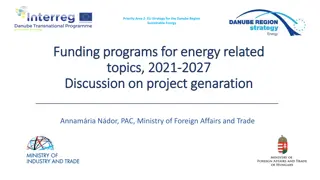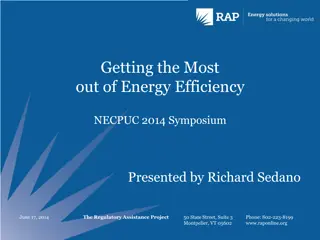Maximizing Impact: $53 Million Philanthropic Funding for Energy Efficiency
Philanthropic funding totaling $53 million has been allocated for energy efficiency initiatives, aiming to complement existing fast-start funding and drive positive impacts in Article 5 countries. The advantages of funding energy efficiency include promoting ozone-friendly, climate-friendly cooling solutions, yielding substantial returns on investment, and reducing lifecycle cooling costs through energy efficiency measures. This funding presents a unique opportunity to accelerate the transition towards sustainable energy practices.
Download Presentation

Please find below an Image/Link to download the presentation.
The content on the website is provided AS IS for your information and personal use only. It may not be sold, licensed, or shared on other websites without obtaining consent from the author.If you encounter any issues during the download, it is possible that the publisher has removed the file from their server.
You are allowed to download the files provided on this website for personal or commercial use, subject to the condition that they are used lawfully. All files are the property of their respective owners.
The content on the website is provided AS IS for your information and personal use only. It may not be sold, licensed, or shared on other websites without obtaining consent from the author.
E N D
Presentation Transcript
Making the Most of $53 Million in Philanthropic Funding for Energy Efficiency October 8, 2016
Fast-start funding package $80 million in new 2017 funding to support an ambitious amendment $27 million in fast-start support from A2 countries for A5 institutional strengthening A group of donor countries have announced their intent to provide additional fast-start support to the MLF in 2017 if an ambitious HFC amendment is adopted this year with a sufficiently early freeze date for Article 5 countries to warrant fast-start support for implementation Designed to help countries quickly implement an ambitious amendment A voluntary one-time plus-up to the MLF of this scale is unprecedented $53 million in philanthropic funding for energy efficiency Single largest philanthropic grant ever made for energy efficiency in this sector Would complement the fast-start funding from A2 countries for an ambitious outcome Designed to be fast, flexible support for the highest priority energy efficiency needs of A5 countries Will be deployed as early as possible in 2017 Philanthropies seeking input on best channels to maximize efficiency benefits for Article 5 countries, e.g. balanced allocation to immediate support through technical consultants/non-profits, MLF, implementing agencies 1
Advantages of funding energy efficiency Opportunity to leapfrog to ozone-friendly, climate-friendly, super-efficient cooling solutions A report by the Lawrence Berkeley National Laboratory estimates that improving energy efficiency of devices that use HFCs could double the climate benefits of an HFC amendment to the Montreal Protocol. Good for the climate Support for smart efficiency policies (e.g. minimum standards) routinely yields 1000 to 1 returns by saving consumers and businesses billions of dollars in avoided energy spending. The philanthropic funding can serve to unlock those positive-return opportunities and spur new private investment. Good for the economy 2
Advantages of funding energy efficiency (II) Relative Contribution of Equipment, Refrigerant, Installation and Operating Costs to Customer Life Cycle 2% 1% 9% A/C Costs India RAC (1.5-ton, R-22) 83% 14% 1% US CAC 37% 54% (3-ton, R-410A) 0% 20% 40% 60% 80% 100% Non-Refrigerant Equipment Cost Installation Cost Refrigerant Cost Life Cycle Energy Cost Energy use is the largest driver of lifecycle A/C system costs, working fluids are the least important, and many alternatives to HFCs offer higher energy efficiency Thus, cutting energy waste can readily reduce lifecycle cooling costs if countries insist on efficiency as part of the transition to ozone-friendly, climate-friendly air conditioning solutions Source: U.S. Department of Energy, The Future of Air Conditioning for Buildings, July 2016 3
Leveraging the $53M for energy efficiency This grant funding in 2017 can support Smart policies that countries seek to implement to cut energy waste and minimize electricity shortfalls Targeted, high-impact pilot projects for emerging cost-effective low-carbon super-efficient cooling solutions Data collection, feasibility studies and market assessments needed before efficiency financing can be scaled up Other technical assistance as requested by Article 5 countries This funding will unlock deeper pools of investment in energy efficiency, notably today s announcement from the World Bank Group To complement and amplify the $53 million in grant funding that philanthropists recently announced to support energy efficiency, the World Bank plans to make available $1 billion in funding for energy efficiency in urban areas by 2020 that could include support for the development and deployment of high-efficiency cooling technologies that also use climate- friendly refrigerants. To cite one example of how this funding could be used, the WB and Vietnam are currently finalizing an operation to support industrial energy efficiency in Vietnam. This will combine IBRD lending ($200m), funding requested from the GCF ($80m) and a donor grant contribution ($10m) 1. Source: SDLC 4
Case study 1: Energy Efficiency Policy in Ghana Ghana s Electrical Appliance Labelling and Standards Program (GEALSP) partnered with CLASP to develop standards and labels, starting with room air conditioner standards. Later included lighting systems, refrigerators, and deep freezers. Redesigned Ghana s energy label to more effectively relay energy efficiency information to consumers. The Program The room air conditioner standard alone will Save consumers $64 million annually in energy bills mitigate 2.8 million tons of carbon dioxide emissions over 30 years Refrigerator policy will save consumers $72 million per year Also reduced Ghana s peak energy load problem The Results How Support from technical consultants and non-profits to implement the efficiency policies Assessment of the opportunity, pilot studies, technical and implementation assistance philanthropic funding could be used Source: clasp.ngo 5
Case study 2: Efficient lighting & cooling in India India s Energy Efficiency Services Limited (EESL)1 replaced 750,000 incandescent lamps with LEDs in Puducherry (pilot region) The Puducherry Electricity Department agreed to procure energy efficiency as a resource and pay EESL for energy saved The model has been scaled up across the country EESL recently announced it would expand the model to super- efficient air conditioning The Program With more than 167 million LEDs now distributed, estimated daily cost savings are more than $3 million and estimated daily carbon dioxide mitigated is over 48,000 tons Due to bulk procurement, LED price has fallen by more than 75% The Results How Assessment of the opportunity, pilot studies, technical and implementation assistance philanthropic funding could be used 1. In partnership with Shakti Foundation and the International Institute for Energy Conservation Sources: shaktifoundation.in and ujala.gov.in 6
We welcome your input Questions for discussion What are your preferred channels for the 2017 efficiency grant funding to flow through to ensure fastest and most impactful support? Are there other categories of potential types of projects that we ve missed here? (We listed policy support; targeted, high-impact projects; data collection and feasibility studies; and other technical assistance.) What are your most critical needs for energy efficiency that you would like to see this funding go towards in 2017? 7























